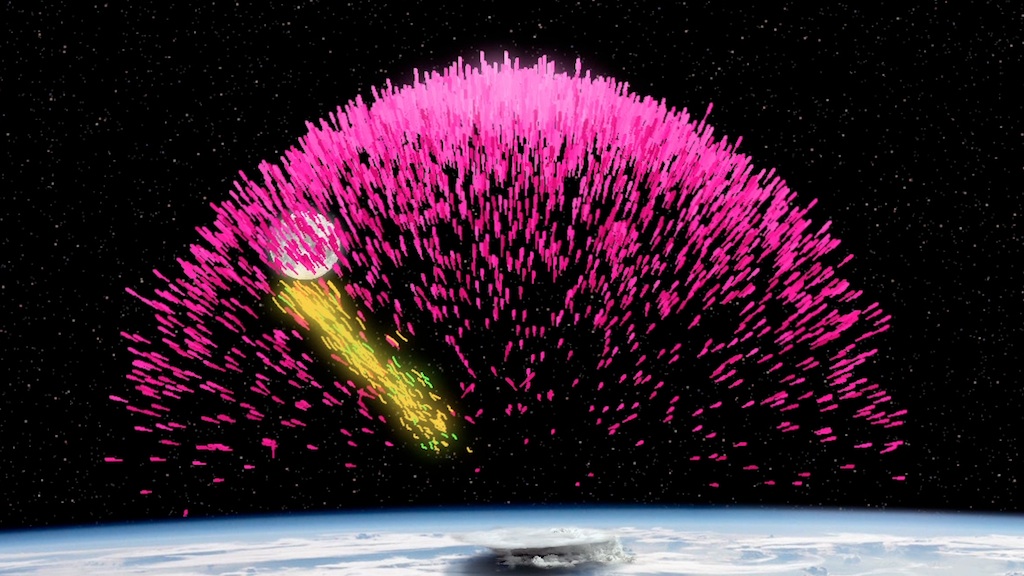What is antimatter?
Information about matter's mirror, antimatter.

Antimatter is the same as ordinary matter except that it has the opposite electric charge. For instance, an electron, which has a negative charge, has an antimatter partner known as a positron. A positron is a particle with the same mass as an electron but a positive charge.
Particles with no electric charge, like neutrons, are often their own antimatter partners. But researchers have yet to determine if mysterious tiny particles known as neutrinos, which are also neutral, are their own antiparticles.
Although it may sound like something out of science fiction, antimatter is real. Antimatter was created along with matter after the Big Bang. But antimatter is rare in today's universe, and scientists aren't sure why.
Where is antimatter, and how is antimatter made?
Humans have created antimatter particles using ultra-high-speed collisions at huge particle accelerators such as the Large Hadron Collider, which is located outside Geneva and operated by CERN (the European Organization for Nuclear Research). Several experiments at CERN create antihydrogen, the antimatter twin of the element hydrogen. The most complex antimatter element produced to date is antihelium, the counterpart to helium.
There are also naturally produced antiparticles made sporadically throughout the universe. But when matter and antimatter meet, they annihilate each other and produce energy, meaning that in a matter-dominated cosmos such as ours, antimatter doesn't stick around very long.
Antimatter is also at the heart of a mystery about why the universe exists at all. In the first moments after the Big Bang, only energy existed. As the universe cooled and expanded, particles of both matter and antimatter were produced. Scientists have measured the properties of particles and antiparticles with extremely high precision and found that both behave identically. So if antimatter and matter were created in equal amounts and they behave identically, all the matter and antimatter created at the beginning of time should have annihilated on contact, leaving nothing behind.
Why matter came to dominate over antimatter is a major mystery.
Get the world’s most fascinating discoveries delivered straight to your inbox.
One theory suggests that more matter than antimatter was created in the beginning of the universe, so that even after mutual annihilation, there was enough matter left to form stars, galaxies and, eventually, everything on Earth. The discrepancy would have been very tiny. Less than 1 in 1 billion ordinary particles would have survived the chaos and gone on to form all the matter around us today, according to Space.com, a Live Science sister site.
If the neutrino — a tiny, ghostly particle that barely interacts with other matter — actually is its own antiparticle, that might be the key to solving this problem. In this theory, at the start of time, a small fraction of neutrinos would have been able to transition from antimatter to matter, potentially creating a slight matter imbalance at the universe's inception. Experiments have tried to determine if the neutrino is its own antiparticle, but so far, they have turned up inconclusive.
Prediction and Nobel Prize
British physicist Paul Dirac predicted antimatter in 1928 while trying to combine quantum mechanics, which describes subatomic particles, and Einstein's theory of relativity. Dirac was looking at solutions to an equation that described the movement of an electron traveling near the speed of light. "Just as the equation x^2 = 4 can have two possible solutions (x = 2 or x = minus −2), so Dirac's equation could have two solutions, one for an electron with positive energy, and one for an electron with negative energy," according to CERN.
At first, Dirac was hesitant about sharing his findings. But eventually, he embraced them and said every particle in the universe should have a mirror-image particle that behaved like it but had an opposite charge.
Positrons were discovered a few years later by American California Institute of Technology physicist Carl Anderson, who was studying highly energetic cosmic rays that come from space and hit Earth's atmosphere, producing a shower of other particles. In his detector, Anderson witnessed a trace of something with the same mass as an electron but with a positive charge. An editor at the journal Physical Review suggested the name positron for the particle, according to the American Institute of Physics.
For their work on this discovery, Dirac and Anderson received the Nobel Prize in physics — Dirac in 1933, and Anderson in 1936.
Antimatter spaceship?
Because putting matter and antimatter together produces energy, engineers have speculated that antimatter-powered spacecraft might be an efficient way to explore the universe.
NASA has studied the possibility of using antimatter-driven vehicles to fly to Mars, but the idea has some downsides. For one, it's really expensive.
"A rough estimate to produce the 10 milligrams of positrons needed for a human Mars mission is about 250 million dollars using technology that is currently under development," Gerald Smith of Positronics Research LLC, in Santa Fe, New Mexico, said in a 2006 article for NASA. The cost might seem high, but it still costs around $10,000 per pound to send something into orbit, so a large spaceship plus its human crew would also be expensive to launch.
More recently, NASA researchers have looked at the possibility of using the energy produced by matter-antimatter collisions to send a probe to the nearest star system, Alpha Centauri. The energy in the collisions would allow the vehicle to accelerate to 10% the speed of light and then slow itself enough to explore Alpha Centauri, potentially for decades.
Additional resources

Adam Mann is a freelance journalist with over a decade of experience, specializing in astronomy and physics stories. He has a bachelor's degree in astrophysics from UC Berkeley. His work has appeared in the New Yorker, New York Times, National Geographic, Wall Street Journal, Wired, Nature, Science, and many other places. He lives in Oakland, California, where he enjoys riding his bike.


